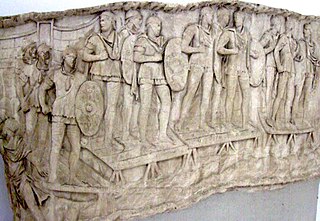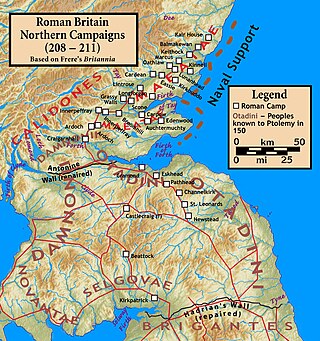
Lucius Septimius Severus was Roman emperor from 193 to 211. He was born in Leptis Magna in the Roman province of Africa. As a young man he advanced through the customary succession of offices under the reigns of Marcus Aurelius and Commodus. Severus was the final contender to seize power after the death of the emperor Pertinax in 193 during the Year of the Five Emperors.

Legio XXII Primigenia was a legion of the Imperial Roman army dedicated to the goddess Fortuna Primigenia. Founded in AD 39 by the emperor Caligula for use in his campaigns in Germania, the XXII Primigenia spent much of their time in Mogontiacum up to the end of the 3rd century. The legion's symbols were a Capricorn and the demigod Hercules.

Britannia Superior was a province of Roman Britain created after the civil war between Septimius Severus and Clodius Albinus. Although Herodian credits Severus with dividing Roman Britain into the Northern territory of Britannia Inferior and the Southern territory of Britannia Superior, modern scholarship argues that it is more likely that Caracalla was the person who made the split sometime in the early 3rd century CE. The previous British capital Londinium remained the centre of Britannia Superior while Eboracum, or modern York was the capital of Britannia Inferior. Epigraphical evidence shows that Upper Britain encompassed approximately what is now Wales, southern England and East Anglia. However, the official boundary between Britannia Superior and Inferior is still unclear.

Britannia Inferior was a new province carved out of Roman Britain probably around AD 197 during the reforms of Septimius Severus although the division may have occurred later, between 211 and 220, under Caracalla. The removal of the governors in Londinium from control over the legions guarding Hadrian's Wall was aimed at reducing their power, given Clodius Albinus's recent bid to become emperor. The province was probably formalised around 214 by Severus's son Caracalla.

The auxilia were introduced as non-citizen troops attached to the citizen legions by Augustus after his reorganisation of the Imperial Roman army from 27 BC. By the 2nd century, the Auxilia contained the same number of infantry as the legions and, in addition, provided almost all of the Roman army's cavalry and more specialised troops. The auxilia thus represented three-fifths of Rome's regular land forces at that time. Like their legionary counterparts, auxiliary recruits were mostly volunteers, not conscripts.
Cohors quarta Gallorum equitata was a Roman auxiliary cohort containing both infantry and cavalry contingents.
Cohors prima Aquitanorum veterana was a Roman auxiliary infantry regiment. It was probably originally raised in Gallia Aquitania in the reign of founder-emperor Augustus after the revolt of the Aquitani was suppressed in 26 BC. Unlike most Gauls, the Aquitani were not Celtic-speaking but spoke Aquitanian, a now extinct non- Indo-European language closely related to Basque.
Cohors prima Aquitanorum was a Roman auxiliary infantry regiment. It was probably originally raised in Gallia Aquitania in the reign of founder-emperor Augustus after the revolt of the Aquitani was suppressed in 26 BC. Unlike most Gauls, the Aquitani were not Celtic-speaking but spoke Aquitanian, a now extinct non Indo-European language closely related to Basque.
Cohors tertia Aquitanorum equitata civium Romanorum was a Roman auxiliary mixed infantry and cavalry regiment. It may have been originally raised in Gallia Aquitania in the reign of founder-emperor Augustus after the revolt of the Aquitani was suppressed in 26 BC. Alternatively, it may have been raised by emperor Claudius to replace regiments stationed in the newly annexed province of Britannia. Unlike most Gauls, the Aquitani were not Celtic-speaking but spoke Aquitanian, a now extinct non Indo-European language closely related to Basque.
Cohors prima Raetorum was a Roman auxiliary infantry regiment. It is named after the Raeti, a designation probably given to some Alpine tribes, which were part of the eponymous province Raetia et Vindelicum, later called simply Raetia. It comprised much of modern Switzerland, western Austria and Germany south of the river Danube. The Raeti originally spoke a non Indo-European language that seems related to Etruscan. However, by the time their territory was annexed by Rome under founder-emperor Augustus, they had become largely Celtic-speaking through contact with neighbouring peoples such as the Vindelici. Finally, during the centuries of Roman rule, they became Latin speakers: their distinctive provincial patois survives today in the form of the Rhaeto-Romance languages.
Cohors prima Delmatarum was a Roman auxiliary infantry regiment. It is named after the Dalmatae, an Illyrian-speaking tribe that inhabited the Adriatic coastal mountain range of the eponymous Dalmatia. The ancient geographer Strabo describes these mountains as extremely rugged, and the Dalmatae as backward and warlike. He claims that they did not use money long after their neighbours adopted it and that they "made war on the Romans for a long time". He also criticises the Dalmatae, a nation of pastoralists, for turning fertile plains into sheep pasture. Indeed, the name of the tribe itself is believed to mean "shepherds", derived from the Illyrian word delme ("sheep"). The final time this people fought against Rome was in the Illyrian revolt of 6–9 AD. The revolt was started by Dalmatae auxiliary forces and soon spread all over Dalmatia and Pannonia. The resulting war was described by the Roman writer Suetonius as the most difficult faced by Rome since the Punic Wars two centuries earlier. But after the war, the Dalmatae became a loyal and important source of recruits for the Roman army.
Cohors secunda Delmatarum was a Roman auxiliary infantry regiment.
Cohors quarta Delmatarum was a Roman auxiliary infantry regiment raised in the 1st century AD and continuing to serve into the 2nd century.
Cohors prima Delmatarum milliaria equitata was a Roman auxiliary mixed infantry and cavalry regiment. It was named after, and originally recruited from, the Dalmatae, an Illyrian-speaking people that inhabited the Adriatic coastal mountain range of the eponymous Dalmatia.

The Roman invasion of Caledonia was launched in 208 by the Roman emperor Septimius Severus. The invasion lasted until late 210, when the emperor became ill and died at Eboracum (York) on 4 February 211. The war started well for the Romans with Severus managing to quickly reach the Antonine Wall, but when Severus pushed north into the highlands he became bogged down in a guerrilla war and he was never able to fully subjugate Caledonia. He reoccupied many forts built by Agricola over 100 years earlier, following the Battle of Mons Graupius, and crippled the ability of the Caledonians to raid Roman Britain.
The Cohors VI Nerviorum was an auxiliary unit of Roman Army Cohors quinquagenaria peditata type attested in the Roman province of Britannia from the second century to the early fifth century AD.
Cohors PrimÆ Ælia Dacorvm was an infantry regiment of the Auxilia corps of the Imperial Roman army. It was first raised by the Roman emperor Hadrian in the Roman province of Dacia not later than AD 125 and its last surviving record dates c. 400. It was deployed, for virtually its entire history, in forts on Hadrian's Wall on the northern frontier of Britannia province.
Cohors prima Ulpia Dacorum was an infantry regiment of the Auxilia corps of the Imperial Roman army. It was founded by the Roman emperor Trajan, probably in preparation for his planned war against Parthia (113-6). The regiment's honorific title Ulpia refers to the emperor's gens, or clan-name.

The frontier of the Roman Empire in Britain is sometimes styled Limes Britannicus by authors for the boundaries, including fortifications and defensive ramparts, that were built to protect Roman Britain. These defences existed from the 1st to the 5th centuries AD and ran through the territory of present-day England, Scotland and Wales.






